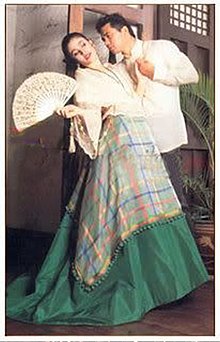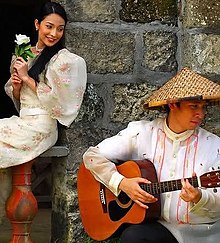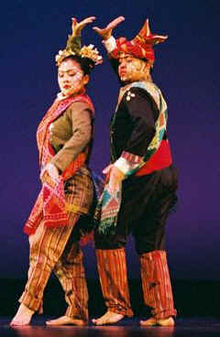Courtship in the Philippines

Traditional courtship in the Philippines is described as a "far more subdued and indirect"
General overview

Often, a
After the girlfriend-boyfriend;
Other courtship practices
Tagalog and Ilocos regions

Apart from the general background explained above, there are other similar and unique courting practices adhered to by Filipinos in other different regions of the Philippine archipelago. In the island of
Rooster courtship is also another form of courting in Luzon. In this type of courtship, the rooster is assigned that task of being a "middleman", a "negotiator", or a "go-between", wherein the male chicken is left to stay in the home of the courted to crow every single morning for the admired lady's family.[3]
In the province of
The Ifugao of northern Luzon practices a courtship called ca-i-sing (this practice is known as the ebgan to the Kalinga tribes and as pangis to the Tingguian tribes), wherein males and females are separated into "houses". The house for the Filipino males is called the Ato, while the house for Filipino females is known as the olog or agamang. The males visit the females in the olog – the "betrothal house" – to sing romantic songs. The females reply to these songs also through singing. The ongoing courtship ritual is overseen by a married elder or a childless widow who keeps the parents of the participating males and females well informed of the progress of the courtship process.[5]
After the courtship process, the
Pangasinan region
In Pangasinan, the Pangasinenses utilizes the taga-amo, which literally means "tamer", a form of love potions or charms which can be rubbed to the skin of the admired. It can also be in the form of drinkable potions. The suitor may also resort to the use of palabas, meaning show or drama, wherein the Filipino woman succumbs to revealing her love to her suitor, who at one time will pretend or act as if he will be committing suicide if the lady does not divulge her true feelings.[3]
Apayao region
The Apayaos allow the practice of sleeping together during the night. This is known as liberal courtship or mahal-alay in the vernacular. This form of courting assists in assessing the woman's feeling for her lover.[3]
Palawan region
In
Visayas region
When courting, the Cebuanos also resort to serenading, which is known locally as balak. They also write love letters that are sent via a trusted friend or a relative of the courted woman. Presents are not only given to the woman being courted, but also to her relatives. Similar to the practice in the Pangasinan region, as mentioned above, the Cebuanos also use love potions to win the affection of the Filipino woman.[3]
People from Leyte performs the pangagad'[5] or paninilbihan or "servitude",[4] instead of paying a form of dowry[5] during the courtship period. In this form of courting, the Filipino suitor accomplishes household and farm chores for the family of the Filipino woman. The service normally lasts for approximately a year before the man and woman can get married.[3] The Tagalogs of Luzon also refers to this courtship custom as paninilbihan meaning "being of service", but is also referred to as subok meaning a trial or test period for the serving suitor. The Bicolanos of Luzon's Bicol region, call this custom as the pamianan.[5] The practice of performing paninilbihan, throwing the rice over bride and groom for prosperity, paying dowry, visiting a shrine to pray for fertility, etc. are among strong traces of continuity of Hindu influence in Philippines,[6] even the term "asawa" (from swami in sanskrit) for the spouse is a loan word from the Indian language sanskrit.[7]
Mindanao region

Reckless courtship, known in the vernacular as palabas, sarakahan tupul, or magpasumbahi, is practiced by the Tausog people of Mindanao. Similar to the palabas version practiced in Luzon island, a suitor would threaten to stab his heart while in front of the courted woman's father. If the father of the woman refuses to give his daughter's hand to the suitor, the suitor is smitten by a knife.[3]
The Bagobo, on the other hand, sends a knife or a spear as a gift to the home of the courted woman for inspection. Accepting the weapon is equivalent to accepting the Filipino man's romantic intention and advances.[3]
19th-century Hispanic Philippines
During the 19th century in
Modern-day influences
Through the
Other than the so-called modern Philippine courtship through texting and social media, there is another modern style that is not widely discussed in public discourse:
See also
References
- ^ a b c Filipino Courtship Customs – How to court a Filipina, asiandatingzone.com
- ^ a b c d Alegre, Edilberto. Tuksuhan, Ligawan: Courtship in Philippine Culture, Tagalog Love Words (An Essay), Our loving ways Archived August 27, 2017, at the Wayback Machine, seasite.niu.edu
- ^ a b c d e f g h i j k l m n o p q Courtship in the Philippines Today, SarahGats's Blog, sarahgats.wordpress.com, March 29, 2009
- ^ a b c d e f g h Borja-Slark, Aileen. "Filipino Courtship: Traditional vs. Modern". Archived from the original on July 18, 2011. Retrieved September 19, 2012.
- ^ a b c d e f g h i Love and Romance Filipino Style Archived January 27, 2010, at the Wayback Machine and Family Structure Archived February 24, 2012, at the Wayback Machine: The Betrothal House (Ifugao, Mountain Province), Courtship Through Poetry and Song (Ilocos province), The Eve of the Wedding (Province of Batangas), The Formal Proposal (Province of Cebu), Bride Service (Province of Leyte), The Wedding (Tausug), livinginthephilippines.com
- Rex Bookstore, p. 35.
- Rex Bookstore, p. 49.
- ^ Ocampo, Ambeth R. Fan Language, Looking Back, Philippine Daily Inquirer, February 2, 2005, page 13, news.google.com
